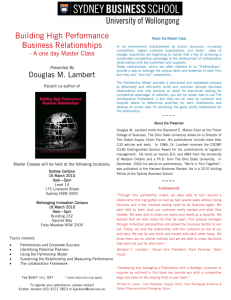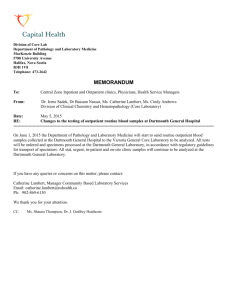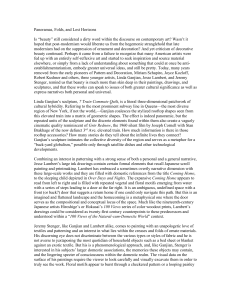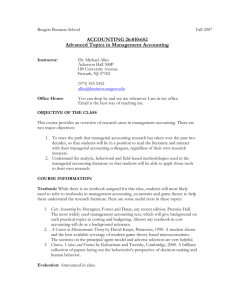Presentation of J.H. Lambert’s text “Vorstellung der Gr¨oßen durch Figuren”
advertisement
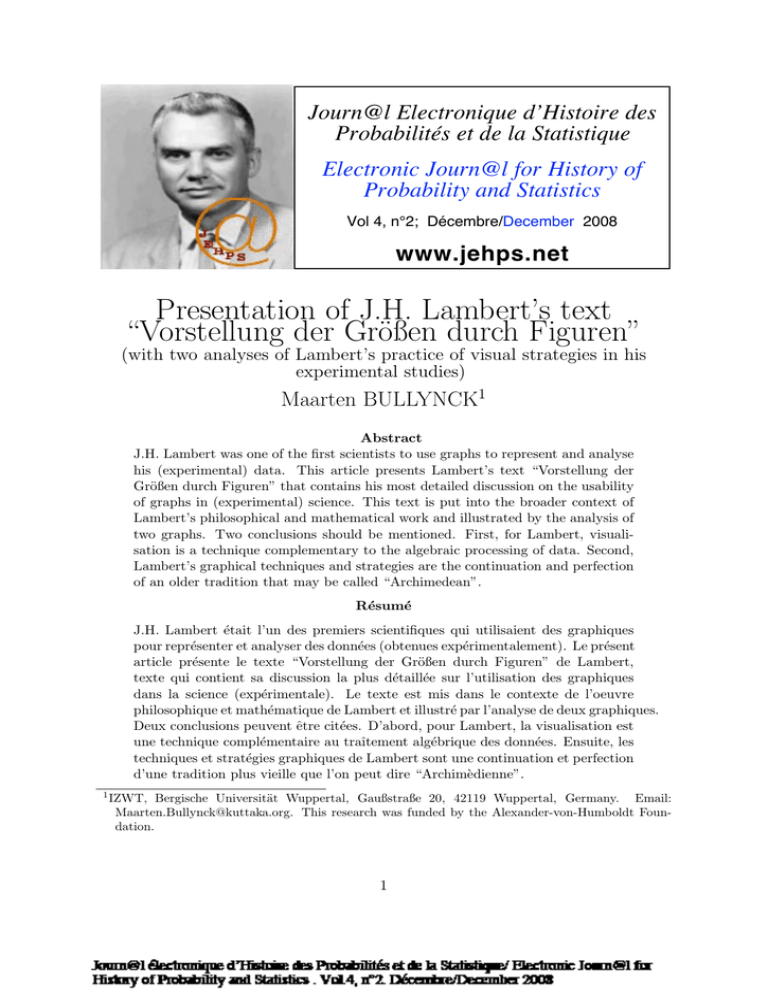
Journ@l Electronique d’Histoire des Probabilités et de la Statistique Electronic Journ@l for History of Probability and Statistics Vol 4, n°2; Décembre/December 2008 www.jehps.net Presentation of J.H. Lambert’s text “Vorstellung der Größen durch Figuren” (with two analyses of Lambert’s practice of visual strategies in his experimental studies) Maarten BULLYNCK1 Abstract J.H. Lambert was one of the first scientists to use graphs to represent and analyse his (experimental) data. This article presents Lambert’s text “Vorstellung der Größen durch Figuren” that contains his most detailed discussion on the usability of graphs in (experimental) science. This text is put into the broader context of Lambert’s philosophical and mathematical work and illustrated by the analysis of two graphs. Two conclusions should be mentioned. First, for Lambert, visualisation is a technique complementary to the algebraic processing of data. Second, Lambert’s graphical techniques and strategies are the continuation and perfection of an older tradition that may be called “Archimedean”. Résumé J.H. Lambert était l’un des premiers scientifiques qui utilisaient des graphiques pour représenter et analyser des données (obtenues expérimentalement). Le présent article présente le texte “Vorstellung der Größen durch Figuren” de Lambert, texte qui contient sa discussion la plus détaillée sur l’utilisation des graphiques dans la science (expérimentale). Le texte est mis dans le contexte de l’oeuvre philosophique et mathématique de Lambert et illustré par l’analyse de deux graphiques. Deux conclusions peuvent être citées. D’abord, pour Lambert, la visualisation est une technique complémentaire au traı̂tement algébrique des données. Ensuite, les techniques et stratégies graphiques de Lambert sont une continuation et perfection d’une tradition plus vieille que l’on peut dire “Archimèdienne”. 1 IZWT, Bergische Universität Wuppertal, Gaußstraße 20, 42119 Wuppertal, Germany. Email: Maarten.Bullynck@kuttaka.org. This research was funded by the Alexander-von-Humboldt Foundation. 1 Johann Heinrich Lambert (1728–1777) has since at least 1966 [Sheynin, 1966] been recognised as one of the founding fathers of the theory of errors and also as one of the forerunners in using graphical methods to display his data. Mainly in the 1970ies aspects of his work have been rediscovered and discussed2 , and in more recent years Lambert’s contributions have attracted renewed interest.3 Unfortunately, nobody thus far has attempted an integrative presentation of Lambert’s thoughts and work pertaining to the theory of errors and graphical display on a more general level, viz. as a set of methods and strategies to process (large sets of) data. As a consequence, the many contributions Lambert made to such data processing avant la lettre appear as rather disconnected topics or loose ends, instead of parts of a systematic thought and philosophy. In this article I want to add a new text to the corpus of Lambert’s work on the representation and analysis of data by graphs. This text, “Vorstellung der Größen durch Figuren”4 , was written in 1765 – according to Lambert’s scientific diary, the Monatsbuch [Bopp, 1916, p. 28] – as a part of the Anlage zur Architectonic [Lambert, 1771, 32nd Chapter]. After the Neues Organon [Lambert, 1764], written and published in 1764, Lambert had started writing his second main philosophical opus, the Anlage zur Architectonic. Though the text was finished by end of 1765, it was only published 6 years later in 1771. Its 32nd chapter, “Vorstellung der Größen durch Figuren” (hereafter abbreviated as VGF), discusses the use of graphs in experimental science, their construction, their mathematical analysis and some heuristic methods that can be applied in this connection. In a first section I will situate Lambert’s text in his oeuvre. This includes a discussion of its place in Lambert’s philosophical thought, and its place within the evolution of Lambert’s thought on the usability of graphs in science.5 In a second section the content of the text (VGF) is briefly described and analysed. In the last section Lambert’s application of the ideas and methods expounded in VGF will be analysed. It is hoped for that Lambert’s text, “Vorstellung der Größen durch Figuren” (VGF) and this accompanying essay may contribute to a deeper and richer appreciation and interpretation of Lambert’s work. See [Sheynin, 1970/1971a;/; Tilling, 1975; Gray and Tilling, 1978; Shafer, 1978; Beniger and Robyn, 1978]. 3 See [Barbut et al., 2005; Martin, 2006; Rohrbasser and Véron, 2006]. 4 Translation: the representation of quantities by figures. 5 This section will make clear that the following statement of Laura Tilling is erronous and should be corrected: “Although [Lambert] wrote several lengthy philosophical treatises where his ideas on scientific investigation are set down, these ideas rarely overflowed explicitly into his scientific writings, and in any case there was little in his philosophical writings that coould define the actual detail of procedure for scientific investigation. Graphs are certainly not mentioned.” [Tilling, 1975, p. 204], cfr. also [Gray and Tilling, 1978, p. 24] In another article (in progress) I will show how Lambert’s philosophical work explicitly provides a very detailed framework and heuristics for scientific investigation, and that Lambert’s own scientific work explicitly refers to this philosophical framework and consequently applies its procedures. In this article, the focus is narrower; we will discuss Lambert’s detailed meditations on the use of graphs and also hint at the philosophical framework in which Lambert understands his work on the theory of errors. 2 2 1 Situation of the text in Lambert’s Oeuvre 1.1 Origins and the philosophical embedding Lambert’s original involvement with graphical methods and with the theory of errors seems to have originated at the same time. In the Monatsbuch one finds [Bopp, 1916, p. 12] that in 1752 Lambert wrote the first sketch on perspective [Lambert, 1752/1943] and also read Johann Jakob Marinoni’s book on charts and surveying using the mensula praetoriana (the plane table) [Marinoni, 1751]. This book, De re ichnographica, by the Vienna court astronomer Marinoni (1676–1755) avails itself as the starting point for Lambert’s first thoughts on how to handle errors.6 In Lambert’s 1752 sketch on perspective, one reads the following important first paragraph: Visible things appear to our eyes often in a different form than they really are. [Lambert, 1752/1943, p. 161]7 This idea is also central in Lambert’s main philosophical work, the Neues Organon [Lambert, 1764], especially in the fourth part on Phänomenologie, the science of appearances. There we read: Researchers on optics [...] have, with the invention of perspective, provided a means to draw the appearance of visible things, [...] thus enabling to imprint both the thing itself and its representation from specific viewpoints on the retina. [...] We remark this especially because, if we view phenomology as a transcendent optics, we also think of a transcendent perspective, and the language of appearances. [Lambert, 1764, Phänomenologie, §5]8 Although it is unavoidable that we can only perceive, record and measure the appearances of this world, and that we thus have to speak the “language of appearances” (“Sprache des Scheins”), there are techniques to optimally represent appearances. Instances of these are perspective drawings and figures made with a plane table or graphs As the Monatsbuch [Bopp, 1916, p. 35] records: “1759: Calculos errorum Marinonii in compendium contraxi, Theorie der Zuverlässigkeit der Beobachtungen und Versuche.”, a renewed occupation with Marinoni’s book immediately precedes the writing down of Lambert’s main contributions to the theory of errors. For the best discussion so far of the sources of Lambert’s theory of errors, including Marinoni we refer to [Knobloch, 1990, pp. 314–318]. In 1995/6, Zeno Swijtink announced a project on instruments and statistics, touching extensively on Lambert’s work in relation to Marinoni and the mensula praetoriana, but nothing seems to have materialised from this. See www.sonoma.edu/users/s/swijtink/vita.htm. 7 Original: “Die sichtbaren Sachen stellen sich unseren Augen öfters weit in anderer Gestalt vor, als sie in der That sind.” 8 Original: “Die Optiker [...] haben in der Perspective Mittel angegeben, den Schein der sichtbaren Dinge zu malen, [...] daß sowohl die Gegenstände selbst, als die Zeichnung, aus den angegebenen Gesichtspunkten betrachtet, einerley Bild auf dem Augennetze machen. [...] Wir merken dieses hier um desto mehr an, weil, wenn wir die Phänomenologie als eine transcendente Optik ansehen, wir uns ebenfalls eine transcendente Perspective, und Sprache des Scheins gedenken.” 6 3 on paper. In the third part of the Neues Organon, the Semiotik, Lambert discerns two general categories of representational techniques that serve as instruments and/or media of cognition: Figur and Zeichen. That is, the graphical, visual representation and the representation through a concatenation of signs, be they alphabetic or numerical [Lambert, 1764, Semiotik, §52-64].9 The first category represents a singular case, the concrete details (§57–58), whereas the second (the translation into algebra mostly) abstracts from the concrete details, generalises the problem and allows it to be solved (§62–66). In the case of doing experimental physics, Lambert details the relationship between Figur and Zeichen. He does this in the fourth part of the Anlage zur Architectonic, entitled “die Größe” (the quantity), to which Lambert often refers as an “organum quantorum” (an Organon, a toolkit for quantities).10 In this part of the Anlage Lambert discusses aspects of the nature of quantities in physics, how to measure them, how to represent them etc. The 31st and the 32nd chapters are devoted to “Das Zahlengebäude” (“numeration systems”) and VGF respectively. For the theoretical relationship between numbers and figures, reference is made to the aforementioned paragraphs of the Semiotik. How they relate to each other in practical application, in scientific practice, is, however, found in the 30th chapter, “Die Schranken” (“the limits”).11 In this chapter “Die Schranken” Lambert analyses in depth the limits of scientific methods. He begins with a discussion on the limitations of the algebraic method, viz. that in many cases approximation through infinite series is the only option of calculation, but that one has to be careful when using an infinite series, that one has to check whether it converges or diverges, etc. Then he goes on to discuss that the precision of measuring instruments, the number of observations etc. all introduce limits to the precision of the obtained results. Therefore, in many cases, a (mechanical or geometrical) construction or a figure may be as precise or as suitable as a calculation for obtaining results, as long as the precision of the data is less than the precision of the construction or figure (§864-865). [§865] Although one generally regards constructions as unreliable, and therefore, even if more tedious, prefers calculation over construction because one can find with greater precision; it is often the case that one can be satisThis important philosophical distinction between apprehension through figures and through signs goes back at least to Leibniz who introduced it in his “Meditationes de cognitione, veritate et ideis” [Leibniz, 1684]. For Leibniz, however, the cognitio intuitiva (cognition mediated often, though not exclusively through figures, or at least cognition seen and understood “at a glance”) was superior to cognitio symbolica (cognition through signs) as a mode of apprehension. Christian Wolff extended considerably on Leibniz’s text, and devoted a large part of his Psychologia Empirica [Wolff, 1738] to this issue. Contrary to Leibniz, Wolff insisted on the fact that both modes of knowledge are on the same epistemological level, and that especially the symbolic cognition is of the foremost importance in science (algebra being the prime example). Lambert stands in Wolff’s line of tradition. Compare the linguistic analyses of Gerold Ungeheuer on the tradition of the cognitio symbolica in [Ungeheuer, 1990]. For the semiotics of mathematics in the 18th century, we refer to the overview in [Knobloch, 1998]. 10 Philosophical interpretations of this part of Lambert’s work, neglecting its applications and mathematical content, can be found in [Berka, 1973; Basso, 1999, p. 170–172]. 11 The crossreferencing in Chapters 31 and 32 to Chapter 30 makes this apparent. 9 4 fied with a construction, and not only in cases where one wants to know something in a ‘by the way’ fashion, but also in cases where the precision that one wants to obtain through calculation is only an illusion. The cases where this happens are those where the data of calculation come from observations and experiments. If one can construct with greater precision than the precision with which one can observe; then the construction is not only precise enough, but it also shows everything, that is hidden in calculation, at a glance, especially because the method mentioned supra12 can be applied in these cases.13 In general, Lambert advocates the idea that, in certain circumstances, construction may beat calculation. Examples of such constructions are: using tangents on a graph to find the differential, the integration of surfaces by measuring the surface on a graph or weighing the paper etc. 1.2 Lambert’s writing on graphical methods in experimental science As the philosophical embedding makes abundantly clear, for Lambert his algebraic theory of errors and his use of graphs are complementary strategies in doing experimental science. Where the first falls short, the second comes in. However, the first is to be preferred whenever possible, because only calculation guarantees geometrical rigour. In the light of this close interconnection – both philosophically and practically – of algebraic “statistics” and graphical methods, it need not surprise that in all of Lambert’s contributions to the (algebraic) theory of errors, as listed by [Sheynin, 1970/1971b] or [Knobloch, 1990], graphs also appear. The use of graphs in the experimental sciences is mentioned for the first time in 1760, in Lambert’s Photometria [Lambert, 1760]. In paragraphs 271 to 306 one can find Lambert’s first essay on a computational handling of errors and a justification of the arithmetic mean as a good estimate [Sheynin, 1970/1971b, pp. 250–252]. However, paragraphs 396 to 401 contain a discussion on how graphs may help to find the mean error for observations.14 Lambert calls it a method, “that can also be applied in various other cases” [Lambert, 1760, p. 189].15 The method is to draw the observations as The reference in §842 is to a passage in the Photometria, where Lambert’s first published thoughts on graphs in experimental science may be found (see 1.2). 13 Original: “[§865] Ungeachtet man die Constructionen überhaupt vor sehr unzuverläßig ansieht, und daher in den meisten Fällen denselben die Berechnung, auch wenn diese ungleich mühsamer ist, vorzieht, weil man dadurch alles viel schärfer finden kann; so geschieht es doch öfters, daß man sich mit der Construction gar wohl genügen lassen könnte, und zwar nicht nur, wo man die Sache nur beyläufig zu wissen verlanget, sondern wo die Genauigkeit, die man durch die Berechnung zu erhalten sucht, nur erträumet ist. Die Fälle, wo dieses geschieht, sind diejenigen, wo die Data zur Rechnung aus Observationen und Versuchen gefunden werden müssen, oder aus denselben genommen sind. Kann man hiebey genauer construiren, als man hat beobachten können; so ist die Construction nicht nur scharf genug, sondern sie legt gewöhnlich auch alles, was in den Rechnungen verstecket wird, vor Augen, zumal da sich die oben (§842) erwähnte Methode dabey anwenden läßt.” 14 This seems to have gone unnoticed by historiographers thus far. 15 Original: “usus sum methodo, quae plurimus aliis quoque casibus adplicari poterit.” 12 5 cartesian points and connect them with a “hand drawn curve” (“curva manu ducta”), and then read off values between the observed points or analyze the general form of the curve. Thus, one can find the mean value between the observations. However, one should be careful with the mean value thus obtained, as one should be careful with the arithmetic mean [Lambert, 1760, p. 192].16 In a very similar way, Lambert joins remarks on the use of graphs to his two main texts on the theory of errors (the “Anmerkungen und Zusätze...” and “ Theorie der Zuverlässigkeit ...” [Lambert, 1765-1772, pp. 1–313 and pp. 424–488]. The remarks discuss the use of graphs to gather information on the observed data. According to the Monatsbuch, these essays were written 1759, published 1765. The relevant passages are: We have in general two variable quantities x, y, which will be collated with one another by observation, so that we can determine for each value of x, which may be considered as an abscissa, the corresponding ordinate y. Where the experiments or observations completely accurate these ordinates would give a number of points through which a straight or curved line should be drawn. But as thus is not so, the line deviates to a greater or lesser extent from the observational points. It must therefore be drawn in such a way that it comes as near as possible to its true position and goes, as it were, through the middle of the given points. We must distinguish here from the start between two general cases. Thus either the rule for drawing a line is determined by theory, or not. In the latter case no other means remains, than to draw the line freehand, and this serves only to determine, as accurately as can be achieved by construction, the ordinates falling between the observed ordinates, and consequently to find such facts as cannot be observed but which nevertheless are needed. [Lambert, 1765-1772, I, pp. 430–431]17 This is more or less a repetition of the 1760 text in the Photometria. There, Lambert had applied his method to data on the aberration of light, in 1765 he applies it to a mortality table (see 3.1 for an analysis of this graph). Original: “At vero de his numeris idem monendum est, quod supra de medio arithmetico notavimus (§275, 279, 283).” 17 Original: “§9 Wir haben hiebey überhaupt zwo veränderliche Größen x, y, welche durch die Beobachtung mit einander verglichen werden, so daß man für jedes x, so wir als eine Abscisse ansehen können, die dazu gehörende Ordinate y bestimmt. Diese Ordinaten würden eben so viele Puncte geben, wodurch eine gerade oder krumme Linie sollte gezogen werden, wenn die Versuche oder Beobachtungen vollkommen genau wären. Da aber dieses nicht ist, so weicht die Linie mehr oder minder davon ab. Sie muß demnach so gezogen werden, daß sie ihrer wahren Lage am nächsten komme, und zwischen den gegebenen Puncten gleichsam wie Mitten durch gehe. §10. Wir haben hiebey gleich Anfangs zween allgemeine Fälle zu unterscheiden. Denn entweder ist das Gesetz der zu ziehenden Linie durch die Theorie bestimmt, oder nicht. Im letzten Fall bleibt kein ander Mittel, als daß man die Linie von freyer Hand ziehe, und sie dient nur, um die zwischen die observirten Ordinaten fallenden Ordinaten so genau als es durch eine Construction geschehen kann, zu bestimmen, und sie folglich für solche Umstände zu finden, die man nicht hat observiren können, und die man dessen unerachtet gebraucht.” (translation after [Tilling, 1975, p. 205]) 16 6 One paragraph in the 1765 text connects the graphs back to his philosophical theory, viz. the part of “Die Schranken”: We assume that, although the observations have no geometric precision, that their deviation from it is such that one cannot prefer one [observation] over the other, and that all experiments are performed with equal care and selection, therefore the deviation of the true value lies only in the fact that the instrument does not allow greater precision, und that the eye does not discern the smaller differences.18 Lambert’s last and most extensive writing on the usability of graphs in experimental science is in 1765, but published only 1771 in the Anlage zur Architectonic, the text presented here. After 1765 Lambert does not come back to the theme, at least not in a theoretical work. He, however, often applies the methods detailed in VGF during his studies in experimental physics. As Lambert had promised in his Discours de réception upon being received as a member of the Berlin Academy in 1765, his efforts after 1765 would be mainly devoted to experimental physics [Lambert, 1765/1767, p. 514]. Especially in his work on hygrometry and pyrometry, Lambert often took recourse to graphs.19 Therefore, the text presented here may stand as Lambert’s final and most complete statement on the use of graphs in experimental science, crowning a decade of thoughts on the topic and extending, enriching and embedding his previous, rather short statements on graphs in 1760 and 1765. 2 Structure and content of VGF In the 32nd Chapter of the Anlage zur Architectonic, Lambert’s main aim is to show how a well-drawn and hand-drawn graph allows to apply algebraic methods to the observations and the curve(s) that connect them. [§885] One represents all quantities by figures, and this happens 1) to make them visible, 2) because it allows to apply the theorems of geometry to the figure. In this way, the figures are transformed into signs, and the lines thus drawn acquire a particular meaning. Aspects of the graph that acquire meaning are the graph’s tangents, the diameter of the graph’s curving, the surface under a graph etc.20 In general, the observation of Original: “§13. Wir setzen hiebey voraus, daß ungeacht die Observationen keine geometrische Schärfe haben, ihre Abweichung von derselben so sey, daß man keiner vor der anderen einen Vorzug geben könne, oder daß alle Versuche mit gleicher Sorgfalt und Auswahl der Umstände angestellt worden, folglich die Abweichung vom wahren schlechthin daher rühre, daß das Instrument an sich keine grössere Schärfe gebe, und das Auge nicht kleinere Unterschiede bemerke” 19 For a general description of Lambert’s graphs, see [Tilling, 1975], additional comments can be found in [Beniger and Robyn, 1978; Tufte, 1983]. In the next section I will analyse Lambert’s use of graphs in his hygrometric studies as an example. 20 Original: “Dabey erhält nun mehrentheils die Lage der Tangenten, die Subtangente, der Halbmesser des Krümmungskreises, der Flächenraum etc. eine Bedeutung, welche sich auf die Gesetze der Veränderungen der beyden Größen beziehen” 18 7 the graphs, the analysis of its ‘symptoms’ frees the way for a number of ‘strategies’ or ‘techniques’ to find an algebraic curve (a polynomial) that fits the graph. With the analysis of ‘symptoms’, Lamberts goes back to an old tradition, that of Apollonius’s study of conic sections, where the symptomata (geometric characteristics) of a section help to classify, describe and analyse the section in question. This concept was transmitted into the modern age and into modern analysis and algebra. In an adapated (algebraic) form, it had been used to classify, describe and analyse conic sections, quadratic curves and cubic curves. However, the concept of symptoma in Apollonius’s and in newer mathematicians’ work had always been applied to abstract objects, ‘ideal’ sections of a cone, ‘ideal’ algebraic curves. Lambert now adapts the concept and applies it to (hand-drawn) graphs that connect observed points, so as to approximate the (algebraic) curve that connects the observed data. Lambert borrows his list of symptomata from Leonhard Euler. Euler [1748, II, pp. 1– 320] had proposed a classification scheme for cubics in his Introductio in Analysin infinitorum that differed from Newton’s classification system [Newton, 1704, pp. 138–162 and Curvarum Tabulae I-VI]. Both Newton and Euler used symptomata, but whereas Newton classified cubics after the nomenclature of conic sections, Euler used the kind of symptomata still used nowadays in secondary education for the analysis of algebraic curves in general. Lambert lists them extensively: [§887] whether a curved line returns in itself, whether it has branches, that either go on in infinity, or that lie between two points without passing beyond them, whether one or more maxima or minima occur, whether it has one or more inflection points, whether the diameter of the curvature becomes zero somewhere, whether the curved line is made up of disconnected parts, whether it turns around a point in spiral form, whether it has asymptotes, whether it has an axis, and both parts around the axis are the same, how the x and y coordinates should be taken to obtain the simplest algebraic curve (equation), etc. All these are Symptomata of curved lines, that, if they occur, presuppose certain conditions, and show certain characteristics by which they can be recognised. Lambert’s list is actually a contraction of §364–434 of Euler’s Introductio in Analysin infinitorum. These paragraphs on finding the algebraic equation from given properties21 discuss how one can calculate the algebraic equation when given certain symptomata of the curve. Lambert turns Euler’s paragraphs into methods and strategies to find an algebraic equation that (approximately, or locally) fits the empirically deduced symptomata, i.e. that fits the form characteristics the eye discerns in the graph. The middle paragraphs of Lambert’s text (§888–896) discuss the use one can make of the most general symptomata in finding the right algebraic equation. This includes a discussion on the choice of coordinates (§888, choice of X and Y axis; §890-1, choice of the abscissa to lose the constant, linear and quadratic term) and on how one can 21 Their titles are: “De inventione curvarum ex datis applicatarum proprietatibus” and “De inventione curvarum ex aliis proprietatibus”. 8 find a coefficient of the equation sought after by looking at the minima/maxima or at a tangent of the graph (§892-3). §894 and §895 are examples of the methods explained in the preceding paragraphs. Paragraphs 897 to 900 are devoted to another topic: If, locally, the graph resembles either a parabolic-like curve, or a cubic-like curve, one might like to approximate this locality by an easy algebraic expression. For a parabolic-like curve one may start from the first of the following hypothetical equations, for a cubic-like curve from the second: η = aξ + cξ 3 + eξ 5 + etc. η = bξ 2 + dξ 4 + f ξ 6 + etc. Calculating the coefficients of these “only from the observations”22 (i.e., if nothing further is known about the nature of the curve), one can use the following equations (§897 for parabolic resp. §898 cubic case): η = Aξ+Bξ(ξ 2 −m2 )+Cξ(ξ 2 −m2 ).(ξ 2 −n2 )+Dξ(ξ 2 −m2 ).(ξ 2 −n2 ).(ξ 2 −p2 )+ etc. η = Aξ 2 + Bξ 2 (ξ 2 − m2 ) + Cξ 2 (ξ 2 − m2 )(ξ 2 − n2 )+ etc. The m, n, etc. are the x-coordinates of the observations. In general, however, one has to start from (§899) η = aξ + bξ 2 + cξ 3 + dξ 4 + etc. and turn it into η = Aξ + Bξ(ξ − m) + Cξ(ξ − m)(ξ − n) + Dξ(ξ − m)(ξ − n)(ξ − p)+ etc. All these formulae are interpolation formulae that locally fit the observed points. Lambert comments in detail upon the convergence of these formulae and remarks that the first two (the parabolic-like and cubic-like) converge considerably faster than the last general one (§899). Concludingly, it is advantageous to simplify the general form of the equation sought after on the basis of information deduced from the graph. Lambert closes the 32nd chapter of his Anlage zur Architectonic with some tricks to find the point where the tangent touches the graph through construction (§901).23 Using this point, one can, through construction again, approximate the surface under the graph using the well-known theorem by Archimedes that the surface under a parabola is exactly 23 of the triangle made by the tangent on this parabola (§902). This kind of tricks are direct descendants of Lambert’s 1752 lecture of Marinoni’s book on how to use the plane-table in surveying. Marinoni devoted a lot of attention to tricks for approximating an observed surface or the lenght of an observed curve using the plane table. One must add that Marinoni’s Chapters II to IV (where these tricks can be found) are mainly (expanded) repetitions of remarks in Daniel Schwenter’s 17th century description of the Original: “Wir wollen nun noch sehen, wie die Coefficienten bestimmt werden können, wenn man nichts als Observationen vor sich hat.” 23 Lambert had already explained this method, also useful to determine specific points of the curve, in 1765, [Lambert, 1765-1772, I, pp. 484-485, §73] 22 9 plane table [Schwenter, 1618, pp. 83–93].24 Actually, this kind of “mathematics without calculating” or “evalution through construction” belongs to an old tradition that Daniel Schwenter had called “Archimedean Speculation” [Schwenter, 1618, p. 85]. 3 Lambert’s application of visual strategies and calculation in his hygrometric studies 3.1 Lambert’s mortality graph (1765) In the essay “Theorie der Zuverlässigkeit der Beobachtungen und Versuche” Lambert mainly considers methods to adjust an (algebraic) curve to points of observation.25 This is, of course, only possible if one knows a priori (by hypothesis or by deduction from more general principles) what curve one is looking for. In §62 Lambert writes: There are an infinite number of cases where one does not know such an equation [known by the theory of the thing], and where consequently this line has to be drawn by hand such that – if the situation of the points A, a, b, c, d, e, f, etc. is apparently without any order and without rule – the line goes in between all of them and keeps the simplest curvature possible. [Lambert, 1765-1772, I, p. 475]26 In these cases, one has to consider what kind of (algebraic) curves might fit the handdrawn graph a posteriori. If the points through which the graphs go would be exact, one could use Newton’s interpolation methods, but since the points are only obtained through observation, such accuracy is not asked for, even more, would be nefarious because it would incorporate all deviations [Lambert, 1765-1772, I, p. 479, §66]. Lambert refers to his brief discussion on the topic in the Photometria (§63, cfr. 1.2). As a general remark, Lambert adds that it is better to take an equation of few terms and coefficients to avoid extensive calculation.27 Lambert goes on to discuss an example of what to do in such cases. The graph under discussion is the mortality graph, based on the mortality in London from 1753 to 1758 (Fig. 1). His analysis of figure 1 begins as follows (§69): But Marinoni’s Chapter V, “De Variis Ichnographicae Praxis Aberrationibus” (pp. 129–252) introduces new topics that inspired Lambert for his theory of errors. See [Knobloch, 1990]for more details. 25 See [Sheynin, 1970/1971b, 254–255] for a discussion. 26 Original: “Es gibt aber unzählige Fälle, wobey man noch keine solche Gleichung [welche durch die Theorie bekannt sey] hat, und wo folglich diese Linie gleichsam von freyer Hand dergestallt muß gezogen werden, daß sie, so bald die Lage der Puncte A, a, b, c, d, e, f, etc. offenbar etwas unordentlich ist, und sich nach keiner Regel richtet, zwischen denselben durchgehe, und die einförmigste Krümmung behalte.” 27 Original: “Es ist daher ungleich besser, wenn man eine Gleichung von wenigern Gliedern und Coefficienten annimmt, und damit eben so verfährt, wie wir oben gewiesen haben.” (§66) referring to “Wenn in diesen Gleichungen die zwo gesuchten Linien MN, NA höhere Dignitäten bekommen, so wird die Rechnung merklich weitläuftig.” (§57) 24 10 M. BARBUT, J.-M. ROHRBASSER, J. VÉRON 54 de 40 à 100 ans, avec un pas de 10 ans (cf. Figure 1, « Figure VII » de Lambert ; le point A y correspond à l’âge de 45 ans et le point D à 90 ans). Figures 1 and 2: de Mortality Graph, and Fragment theLambert Mortalityen Graph Figure 1. Morceau la courbe de survie donnéeofpar 1765 D’après sa figure, Lambert évalue la population de survivants à l’âge de 45 ans Theà nature this curved linede is 45 unknown. we have pas found drawn (soit y(0) = a) 26 950ofâmes. Cet âge ans n’aAs sûrement étéand choisi au hasard : a posteriori, it is clear D and E there inflection points, C it l’examen des données montre enthat effetatque c’est à peuare près à cet âge que at doit se situer la touches the ordinate, and at B it becomes asymptotic. [Lambert, 1765-1772, e 2 inflexion de la courbe, le sens de la courbure ne change plus au-delà. 28 I, p. 483] Le coefficient a kind de (1) étant ainsi déterminé, il resteobserving à trouver cinq autres. This is exactly the of analysis proposed in VGF §886–6, the les symptomata Lambert negraph. connaît les méthodes de antype « moindres écarts » of the Sincepas two inflection points and asymptote are clearly too manyélaborées charultérieurement par les Laplace, Legendre, Gauss ou Cauchy. La première idée quito peut acteristics to easily determine a curve algebraically, Lambert restricts his attention venir àa l’esprit, c’est de faire passer représentative par cinq part of the graph, between 45 la andcourbe 90 years (Fig. 2) and du triespolynôme to locally (1) approxiit. This (partial) graph has already been discussed B. 70, Sheynin points mate correspondant aux observations ; par exemple, pourby 50,O.60, 80 et[Sheynin, 90 ans (i.e. 29 1970/1971b, p. 249] , who noted that Lambert does not really adjust the curve because x = 5, 15, 25, 35 et 45). On obtient ainsi un système de cinq équations linéaires en b, c, a posteriori curve passes throughMais all points, and by Barbut et al. [Barbut d, e ethis f qu’il ne reste qu’à résoudre. attention auxMarc erreurs d’arrondi, qui vont et al., 2005, pp. 53–55 and 71–72], who re-calculated Lambert’s equation and found an une s’accumuler ! En outre, rien n’assure a priori que le polynôme obtenu aura error in Lambert’s calculation “que nous appelerions d’étourderie”. courbure de sens constant. Lambert himself only describes how he arrives at an equation of the fifth degree that fits partial graph [Lambert, I, 485–488 §72]. il Knowing, Trèsthe astucieusement, Lambert1765-1772, choisit une autre voie : va fairehowever, en sortethat que le Lambert wrote VGF at the time “Theorie der Zuverlässigkeit ...” was published, one polynôme (1) soit tangent à la courbe tracée « à main levée ». Cette évaluation, faite may assume, it contains the theory behind the practice used here. graphiquement, le that conduit aux pentes de -985,7 pour la tangente en Indeed, H (i.e.,Lambert b = -985,7 starts from the general equation given in VGF §899: dans (1)), et de -64 en E. Admirable précision ! y = a + bx + cx2 + dx3 + ex4 + f x5 etc. En faisant passer son polynôme par trois points supplémentaires parmi les observations (en l’occurrence, par ceux correspondant à 60, 70 et 90 ans, x = 15, x = 25 28 Original: “Die Natur dieser krummen Linie ist unbekannt. So wie wir sie aber a posteriori gefunden et x = 45),und il est ainsi conduit au système de 4 équations linéaires : gezeichnet haben, zeigt es sich, daß sie bey D und E zween Wendungspuncte hat, bey C die Ordinate berührt, und bey B asymtotisch wird.” 2 4 1429 Sheynin’s 146 = 26 reference 950 – 985,7. + 15 . c+ 153. d+be15[19]. . e + 155.f is to 15 entry [23], it should 7 435 = 26 950 – 985,7. 25 + 252. c+ 253. d+ 254. e + 255.f 347 = 26 950 – 985,7. 45 + 452. c+ 453. d+ 454. e + 455.f 115. 454.f 64 = – 985,7 + 2.45. c+ 3.452. d+ 4. 453. e + pour déterminer c , d , e et f (pour le calcul algébrique de la dérivée, se reporter à l’Annexe II). Seulement, il a commis une erreur, que nous appellerions « d’étourderie » : après The coefficient a is easily found, as explained in VGF §889. It is equal to the ordinate AH, i.e. 26950. Then, after VGF §893, the coefficient b is the inclination of the graph against the ordinate. Indeed Lambert takes a tangent HT on the curve HE and finds for b −985, 7.30 Finally, Lambert starts to interpolate the rest of the coefficients using the points x, y (x = 15, 25, 45 and y = 14146, 7435, 347) given in the mortality table and the beginning of his graph (for x = 45).31 This leads to four linear equations in four unknowns, which Lambert (slightly incorrectly) solves to arrive at y = 26950−985, 7x+9, 709150x2 −0, 0342700x3 −0, 0027017x4 +0, 000066635x5 [Lambert, 1765-1772, I, p. 488] 3.2 Hygrometric Graphs The exemplifary use of Lambert’s visual strategies on the mortality table in 1765 (written 1759) is followed by a series of uses in his experimental work on physics at the Berlin Academy (1765–1777).32 This happens for the first time in 1769 in his first study on humidity or first part of his hygrometric studies, published 1771 in the Mémoires of the Berlin Academy. Having collected (from own experiences) measurements of the evaporation of water in cylinders of different diameter per day during a certain period, Lambert prints them in a table, but adds “I will not make long comparisons with the numbers in this table, because one can see it d’un seul coup d’oeuil when the numbers change into figures.” [Lambert, 1769/1771, p. 76]33 This methodological statement echoes exactly Lambert’s view on figures and signs. Discussing the graph (Fig. 3 left), Lambert does not really use any of the strategies explained in VGF, but compares the symptomata of the five curves and concludes “they keep a certain parallellism”.34 This enables Lambert to decide in favour of Wallerius’s claim that evaporation is in (linear) propertion with the surfaces that are exposed to the air. No calculation occurs. To show the correlation between temperature and evaporation, Lambert uses a similar strategy. He plots the data of the temperature and of the evaporation over a number of days in the same figure (Fig. 3 right). It becomes immediately clear that the curve of evaporation is dependent on the curve of temperature. Next, to determine the quantitative connection between temperature and evaporation, Lambert visualises his data again (Fig. 4 left). Lambert then transforms this figure completely by mechanical differentiation, thus arriving at another figure that will be the main focus of his further analysis. Marc Barbut et al. [Barbut et al., 2005, pp. 54] qualifify these steps with “astucieusement” and “Admirable précision!”, but in the light of its subtext VGF these steps appear as parts of a systematic procedure, that is indeed admirable, but in no way a product of chance or dare. 31 It is unclear if the interpolation points are chosen so as to enhance the convergence of the computational procedure as discussed in VGF §899. 32 The relevant instances are discussed in [Tilling, 1975, pp. 200-204]. 33 Original: “Je ne m’arrêterai pas à faire de longues comparaisons entre les nombres de cette table, tandis qu’on les fera comme d’un seul coup d’oeil quand ces nombres se changent en figure.” 34 Original: “elles gardent entr’elles un certain parallélisme” 30 12 Figure 3: left: Graphs of the Evaporation of Water in 5 Cylinders with different diameter; right: Graphs of Temperature (oscillating) and Evaporation (decreasing) Figure 4: Graphs of the Evaporation of Water in Relation to Temperature: The left curve DEF is mechanically differentiated through tangents EG to obtain the right curve AC I have used a similar figure [as Fig. 3 left], but drawn on a larger scale, to compare the velocity of evaporation with the degrees of heat. To that end I had to draw for each ordinate PH a tangent EG to deduce it [the velocity][Lambert, 1769/1771, p. 85–6]35 In another essay, published 1770 in the second volume of the Beyträge, Lambert had discussed how to measure lines and angles on a sheet of paper.36 Combined with the method for finding intersection points of tangents on paper (VGF §901), this leads Lambert to Fig. 4 right. Lambert remarks: It would be rather difficult to assign a priori an algebraic equation that Original: “Je me suis servi d’une semblable figure, mais dessinée plus en grand, pour comparer la vitesse de l’évaporation avec les degrés de chaleur. Pour cet effet il fallut pour chaque ordonnée PH tirer une tangente EG, afin d’en inférer.” 36 This essay is “Einige Anmerkungen zur Ausmessung der Winkel und Linien auf dem Papier”, [Lambert, 1765-1772, II, 170–175]. 35 13 satisfies the curve of Figure [4 right] [...] but we can nevertheless indicate the general symptoms that condition this curve. [Lambert, 1769/1771, p. 87]37 This echoes, of course the VGF text. First of all, Lambert clearly enunciates the limitations of the graph as a representation of the physical process. The abscissa (beginning of the curve), although in the graph at 0 degrees, might lie somewhere on the negative side of the X-axis since the curve only approximates but does not cut the axis. Further, if the graph (here drawn up to 60 degrees Réaumur) would be pursued until 80 degrees Réaumur (boiling point) the contours of the graph might change considerably because of the “violent evaporation” [Lambert, 1769/1771, p. 87]. Given these limitations, Lambert decides to approximate the graph locally, between 0 and 60 degrees Réaumur, as a parabolic-like curve.38 Without giving any details (but clearly applying the VGF method §899) Lambert arrives at the equation: y= 2 x 10 + 1 x2 200 + 13 x3 72000 + ... He then renormalises the equation to get: 4 x 3 + 13 x2 + 13 3 x 72 + ... and then remarks that this comes close to x + 12 x2 + 16 x3 + . . . which is the power expansion of ex −1. Ultimately he derives a hypothetical differential equation dy = mydz gouverning the growth of evaporation [Lambert, 1769/1771, p. 90], though only for the ‘regular’ interval given above. Also, the air pressure and the humidity of the air are not taken into account.39 This kind of further development of the equations that fit a graph locally (first into an expression involving exponentials ex , then trying to find a differential equation that generates these) is typical of later explorations of his VGF method, although these explorations never return to the graph for further analysis, but rather proceed in a purely algebraic way. Such explorations, involving fitting graphs to equations like ex , e−x and combinations, can be found in the second essay on hygrometry [Lambert, 1772/1774] and in his second go at the mortality curve [Lambert, 1765-1772, III, 476–569]. 4 Conclusions The use of graphical methods is a theme that runs through Lambert’s work from 1752, the date of his first publication, until Lambert’s premature death in 1777. The idea of Original: “Il seroit assez difficile d’assigner a priori une équation algébrique, qui satisfait à la courbe qu’offre la cinquieme Figure. [...] mais nous pourrons toujours indiquer les symptomes généraux, auxquels cette courbe doit satisfaire.” 38 Original: “nous pourrons en attendant nous borner à lui substituer une courbe du genre parabolique, qui ne s’écarte pas sensiblement depuis 0 jusqu’au 60me degré de chaleur.” [Lambert, 1769/1771, p. 88] 39 Lambert’s equation corresponds more or less to the modern simplified equation dy/dx = −ky for the rate of evaporation. A more elaborate equation, taking into account all circumstances (air pressure, sporadic elements in the water ...) has been given by Penman [1948]. 37 14 applying graphs to visualise experimental data, and using the properties of the graph to apply the algebraic method in cases where it would have been difficult without this graph, seems to have sprung from Lambert’s involvement with instruments of measuring and “reduced” representation, such as perspective drawings and especially drawings on the plane table. This tradition of visual representation and its associated techniques, such as correcting measuring errors on paper, mechanical quadrature etc., is taken by Lambert up to a next level. Lambert brings in algebraic techniques. In a comment on Marinoni, Lambert clearly expresses his idea that the introduction of algebra abbreviates considerably this manual practice or geometric construction. This detour, that causes Marinoni to calculate that many singular cases, disappears when literal calculus [algebra] is introduced, because the mechanical architecture [of algebra] can represent all cases by a simple transformation of signs. [Lambert, 1765-1772, I, p. 236] 40 This is one side of Lambert’s proto-statistical work, the side of calculation and mathematisation, the side that prepares Carl Friedrich Gauss’s work. The other side of Lambert’s work in things statistical still adheres to this practical and technical tradition and is most clearly seen in his use of graphs. The text presented here, “Vorstellung der Größen durch Figuren” is the most accomplished text on this side of Lambert’s work, Lambert’s at times beautiful graphs in his writings on experimental physics (hygrometry, pyrometry, mortality, magnetism) are the witnesses of Lambert’s systematic use of graphs. As, however, the analysis of his hygrometric graphs (see 3.2) makes clear, the VGF text does not discuss all aspects of Lambert’s sometimes ingenious use of graphs in experimental science. For instance, the combined representation of several similar experiments in one graph to discern a “parallellism” between the cases or the superposition of two graphs to find a correlation (Fig. 3) are absent in VGF. More importantly, Lambert’s later work (1769–1772) often arrives at (a combination of) logarithmic functions that fit the experimental graphs. Although the method to fit an (polynomial) equation to points of a graph is discussed in VGF, the transformation of this equation into a logarithmic function that fits the graph is not. Above (3.2, Fig. 4), we discussed the first instance of this procedure in Lambert’s work, but several other instances occur in the second essay on hygrometry and the second text on mortality tables. Lambert nowhere indicated that the method he used in these cases was a systematic one, more even, in most cases he just stated the logarithmic function. In the example above, Lambert “recognises” the pattern of coefficients in the series, in other instances visual similarities between known curves seem to have guided Lambert to fit the curve to a logarithmic function with some trial-and-error.41 Original: “Dieser Umweg, der dem Marinoni die Berechnung so vieler einzelnen Fälle verursacht, fällt bey der Buchstabenrechnung ganz weg, weil ihre Mechanische Einrichtung durch eine bloße Verwandlung der Zeichen alle mögliche Fälle vorstellig macht.” 41 The hypotheses forwarded in [Barbut et al., 2005, pp. 56–62] belong to this second possibility. One should perhaps remark that Lambert edited a collection of mathematical tables that included hyperbolic sines, cosines and tangents as well as list of transformation formulae between series for hyperbolic logarithms (i.e. natural logarithms) and hyperbolic circular functions [Lambert, 1770, 40 15 References Barbut, M., Rohrbasser, J.-M., and Véron, J. (2005): “Lambert et la loi de survie”, Math. & Sci. hum. – Mathematics and Social Sciences, 171 (3), pp. 51–85. Basso, P. (1999): Filosofia e geometria. Lambert interprete di Euclide, volume 183 of Pubblicazioni della facoltà di Lettere e Filosofia dell’Università degli Studi di Milano, Firenze, La nuova Italia. Beniger, J. and Robyn, D. L. (1978): “Quantitative graphics in statistics: A brief history”, American Statistician, 32 (1), pp. 1–11. Berka, K. (1973): “Lambert’s Beitrag zur Meßtheorie”, Organon, 9, pp. 231–241. Bopp, K. (1916): “Johann Heinrich Lamberts Monatsbuch mit den zugehörigen Kommentaren, sowie mit einem Vorwort über den Stand der Lambertforschung”, Abhandlungen der Königlich Bayerischen Akademie der Wissenschaften Mathmematischphysikalische Klasse, 27 (6), pp. 1–84. Euler, L. (1748): Introductio in analysin infinitorum, Lausanne, Bousquet. Gray, J. J. and Tilling, L. (1978): “Johann Heinrich Lambert, mathematician and scientist, 1728–1777”, Historia Mathematica, 5 (1), pp. 13–41. Knobloch, E. (1990): “Zur Genese der Fehlertheorie”, in: A. Heinekamp, W. Lenzen, and M. Schneider, editors, Mathesis rationis, Festschrift für Heinrich Schepers, Münster, Nodus, pp. 301–327. Knobloch, Eberhard (1998): “Zeichenkonzeptionen in der Mathematik von der Renaissance bis zum frü—hen 19. Jahrhundert”, in: Ronald Posner, Klaus Robering, Thomas A. Sebeok, editors, Semiotik/Semiotics, Ein Handbuch zu den zeichentheoretischen Grundlagen von Natur und Kultur, A Handbook on the Sign-Theoretic Foundations of Nature and Culture, 2. Teilband, Berlin, New York, de Gruyter, pp. 1280–1292. Lambert, J. H. (1752/1943): “Anlage zur Perspektive”, in: M. Steck, editor, Schriften zur Perspektive, Berlin, Dr. Georg Lüttke Verlag, pp. 161–186. p. 121; pp. 125–133; pp. 176–181]. These may have helped to “recognise” patterns between numbers in a table, points on a graph or coefficients of series. Lambert himself wrote to Paccassi (6 Dec. 1776) as follows [Lambert, 1781–1787, III, p. 367–368]: “Wegen der Formel S. 483 hat mich auch P. Fontana zu Pavia gefragt, wie ich sie gefunden. [...] Der Exponent 31,682 soll eigentlich 13,682 seyn. Ich hatt die Zahlen der 4ten Columne S. 481 als Ordinaten construirt, wie bereits im ersten Theile der Beyträge erwähnt worden. Ich sah daß eine Parabel besonders die letzten Ordinaten ganz ordentlich vorstellte, und daß es nur darauf ankam, die Abweichung für die ersten Jahren zu 2 bestimmen. Ich berechnete demnach die Werthe 10000. 96−x für x = 2, 5, 10, 20....90, 96, und zog 96 sie von y ab, oder y von denselben. Die Unterschiede gaben eine krumme Linie, welche mit der Linie AQH (Tom.2 Act Helv. Tab VIII fig. 10) viele Aehnlichkeit hatte, und demnach durch den Unterschied zwoer log. Linien vorgestellt werden konnte.” 16 Lambert, J. H. (1760): Photometria sive de mensura et gradibus luminis, colorum et umbra, Basel, Augustae Vindelicorum. Also : Photométrie ou de la mesure et de la gradation de la lumière, des couleurs et de l’ombre, translated by Boye, Couty, Saillard, Paris, L’Harmatton, 1997. Lambert, J. H. (1764): Neues Organon oder Gedanken über die Erforschung und Bezeichnung des Wahren und dessen Unterscheidung vom Irrtum und Schein, Leipzig, Johann Wendler. Lambert, J. H. (1765–1772): Beyträge zum Gebrauche der Mathematik und deren Anwendung, Berlin, Buchhandlung der Realschule, 3 Teile, davon 2. Teil in 2 Abschnitten (1765, 1770, 1772). Lambert, J. H. (1765/1767): “Discours de réception”, Nouveaux Mémoires de l’Académie Royale des Sciences et Belles-Lettres de Berlin, XI, pp. 506–514. Lambert, J. H. (1769/1771): “Essai d’hygrométrie ou sur la mesure de l’humidité”, Nouveaux Mémoires de l’Académie Royale des Sciences et Belles-Lettres de Berlin, pp. 68–127. Lambert, J. H. (1770): Zusätze zu den Logarithmischen und Trigonometrischen Tabellen, Berlin, Spener’sche Buchhandlung. Lambert, J. H. (1771): Anlage zur Architectonic, oder Theorie des Ersten und des Einfachen in der philosophischen und mathematischen Erkenntniß, Riga, Hartknoch. Lambert, J. H. (1772/1774): “Suite de l’essai d’hygrométrie”, Nouveaux Mémoires de l’Académie Royale des Sciences et Belles-Lettres de Berlin, pp. 65–102. Lambert, J. H. (1781–1787): Deutscher gelehrter Briefwechsel, edited by Johann III Bernoulli, Berlin, Selbstverlag, 5 volumes. Leibniz, G. W. (1684): “Meditationes de cognitione, veritate et ideis”, Acta Eruditorum, pp. 537–542. Marinoni, J. J. (1751): De re ichnographica, cujus hodierna praxis exponitur, et propriis exemplis pluribus illustratur, Wien, Kaliwoda. Martin, T. (2006): “Logique du probable de Jacques Bernoulli à J.-H. Lambert”, Journal Electronique d’Histoire des Probabilités et de la Statistique / Electronic Journal for History of Probability and Statistics, 2 (1b), pp. 1–22. Newton, I. (1704): Opticks: or, a Treatise of the Reflexions, Refractions, Inflexions and Colours of Light. Also Two Treatises of the Species and Magnitude of Curvilinear Figures, London, Sam Smith and Benjamin Walford, printers to the Royal Society. Penman, H. L. (1948): “Natural evaporation from open water, bare soil and grass”, Proceedings of the Royal Society of London (Series A), 194, pp. 120–145. 17 Rohrbasser, J. M. and Véron, J., editors (2006): Lambert, Contributions mathématiques à l’étude de la mortalité et de la nuptialité 1765–1772, Paris, INED. Schwenter, D. (1618): Deliciae Geometria Practica Nova: Tractatus III, Mensula Praetoriana: Beschreibung des Nutzlichen Geometrischen Tischleins, Nürnberg, Simon Halbmayer. Shafer, G. (1978): “Nonadditive probabilities in the work of Bernoulli and Lambert”, Archive for the History of Exact Sciences, 19, pp. 309–370. Sheynin, O. B. (1966): “Origin of the theory of errors”, Nature, 211, pp. 1003–1004. Sheynin, O. B. (1970/1971a): “Newton and the classical theory of probability”, Archive for the History of Exact Sciences, 7, pp. 217–243. Sheynin, O. B. (1970/1971b): “J.H. Lambert’s work on probability”, Archive for the History of Exact Sciences, 7 (3), pp. 244–256. Tilling, L. (1975): “Early experimental graphs”, British Journal for the History of Science, 8, pp. 193–213. Tufte, E. R. (1983): The Visual Display of Quantitative Information, Cheshire (CT), Graphics Press 2nd Edition 2001. Ungeheuer, G. (1990): Kommunikationstheoretische Schriften II: Symbolische Erkenntnis und Kommunikation, volume 15 of Aachener Studien zur Semiotik und Kommunikationsforschung, Aachen, Rader Publikationen. Wolff, C. (1738): Psychologia Empirica, Frankfurt and Leipzig, Renger. 18
